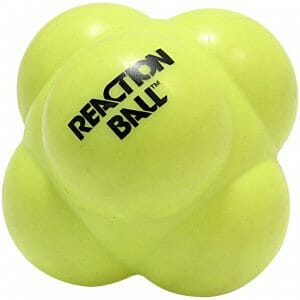June 18, 2015 by Patrick Kelsey in Analysis with 4 comments
As the club regular season gets underway and your focus transitions to your speed and quickness, one of the most important elements of these abilities is your reaction time. Traditional speed exercises don’t necessarily have reactivity built into them. Often they will start with a “gunshot” type cue (or someone yelling “go”), but beyond that, there is very little built in that tests your reaction time.
 One of my favorite reaction training tools is the reaction ball. These are available in sporting goods stores and online, and are definitely worth the buy. To train your brain using this, draw a number on each side. With these numbers drawn on, we can come up with countless games and variations on how to use them. My favorite is to assign a movement for each of the numbers. For example, if you catch the ball with the number 4 facing you, do a burpee, then toss it against the wall and catch again.
One of my favorite reaction training tools is the reaction ball. These are available in sporting goods stores and online, and are definitely worth the buy. To train your brain using this, draw a number on each side. With these numbers drawn on, we can come up with countless games and variations on how to use them. My favorite is to assign a movement for each of the numbers. For example, if you catch the ball with the number 4 facing you, do a burpee, then toss it against the wall and catch again.
You can also challenge yourself to call out the sum total of the numbers and see how fast you can get up to 50 without a mistake. With these added layers, we train not only our reactive quickness, but our mental decision making and specific stimulus reactions as well. These drills are great, but we can get even more specific to ultimate, let’s look at some reactivity drills you can do at practice.
Reactivity drills can be divided into two types: simple and complex. Simple drills are one stimulus (a starting gun) and one action (sprint 40 yards). Complex drills typically involve a choice and are more realistic to sport situations. An examples of this would be running a 5-10-5 in the direction indicated by the coach (“left!” or “right!”) on the start, or a mirroring drill, where you are forced to react to the direction your partner move in.
Here’s a couple Whitecaps testing each other. The player facing us is on “offense” and has the option to start in either direction.
These types of mirror drills are great. To further challenge our reactivity, we need to start with the brain.
It’s very rare in games that we are able to simplify our decision making to one stimulus and one response, so our progressions on these drills will be focused on complexity. We’ll explore here a couple basic reaction drills and then add layers of difficulty by increasing the amount of thinking required to perform each drill. Our 5-10-5 drill can also be tweaked to mimic a more chaotic environment.
In this variation of a reactive start, I’ll indicate with my hand which direction to go in, but I will also yell out a direction. We did 3 reps with the runner following just my hand, then 3 reps following just my voice. Varying the “true” stimulus and the “decoy” frequently helps keep the runner on their toes. I only fooled one of these Whitecaps once, but this is just the beginning of ways in which you can vary this stimulus. This will help your brain learn how to filter out distraction stimuli (fakes and jukes) and focus in on useful information (hip orientation, sideline talk, stall counts, etc).
Let’s look at another type of mirroring or reaction drill: the box mirror.
Here you can see 2 players doing a “perfect mirror” version. This is easiest for most people because it involves very intuitive “beat them to the spot” type of reactions. Note that while offense is going to their right, defense is actually going to their left in order to mirror.
In the first version below, we’ve flipped the defense’s box horizontally, now when offense goes right, defense must go right as well (to the opposite side front cone).
This adds a little challenge and a layer of thinking, which is what we want, but we can make this drill even more realistic to on field defense by flipping the mirror vertically, seen in the second example. Now when offense goes forward, defense goes backward. This variation mimics our defensive cushion that we can use to dictate on D, even when we are reacting.
The final variation we’ll explore is the double mirror flip. This requires the most thinking, left is right AND front is back. This is probably about as crazy as you would want to get with this.
There’s definitely such a thing as too much thinking during sport. We’ll leave the more complex stuff to the chess-boxers. Have fun with these at your next practice.